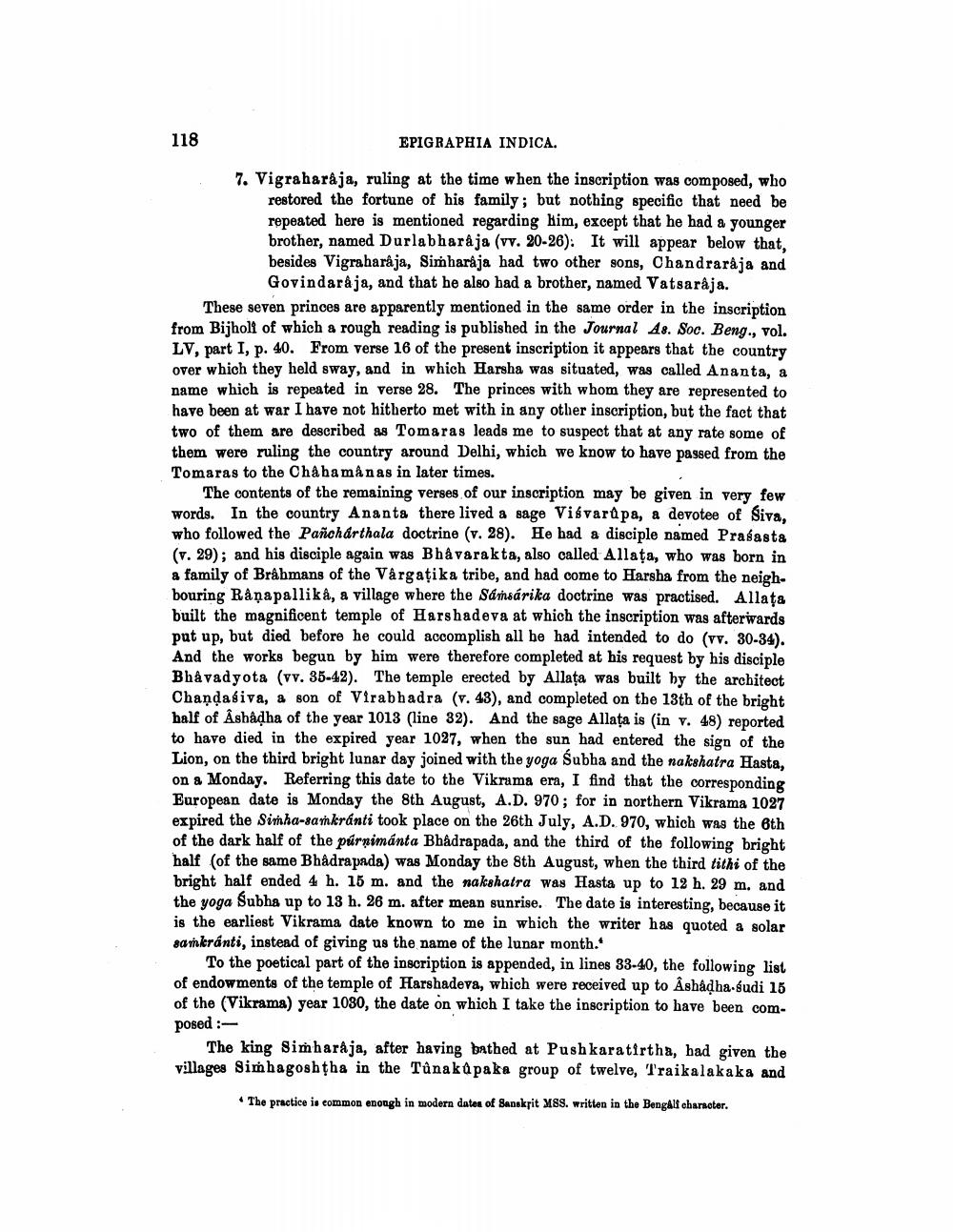________________
118
EPIGRAPHIA INDICA.
: 7. Vigraharaja, ruling at the time when the inscription was composed, who
restored the fortune of his family; but nothing specific that need be repeated here is mentioned regarding him, except that he had a younger brother, named Durlabharaja (vv. 20-26). It will appear below that, besides Vigraharåja, Simharaja had two other sons, Chandraraja and
Govindaraja, and that he also had a brother, named Vatsaraja. These seven princes are apparently mentioned in the same order in the inscription from Bijholi of which a rough reading is published in the Journal As. Soc. Beng., vol. LV, part I, p. 40. From verse 16 of the present inscription it appears that the country over which they held sway, and in which Harsha was situated, was called Ananta, a name which is repeated in verse 28. The princes with whom they are represented to have been at war I have not hitherto met with in any other inscription, but the fact that two of them are described as Tomaras leads me to suspect that at any rate some of them were ruling the country around Delhi, which we know to have passed from the Tomaras to the Chahamånas in later times.
The contents of the remaining verses of our inscription may be given in very few words. In the country Ananta there lived a sage Visvarūpa, a devotee of Siva. who followed the Pancharthala doctrine (v. 28). He had a disciple named Prasasta (v. 29); and his disciple again was Bhå varakta, also called Allaţa, who was born in a family of Brábmans of the Vargaţika tribe, and had come to Harsha from the neighbouring Ranapallika, a village where the Sámsárika doctrine was practised. Allata built the magnificent temple of Harshadeva at which the inscription was afterwards put up, but died before he could accomplish all be had intended to do (vv. 30-34). And the works begun by him were therefore completed at his request by his disciple Bhavadyota (vv. 35-42). The temple erected by Allata was built by the architect Chandasiva, a son of Virabhadra (v. 43), and completed on the 13th of the bright half of Ashâdha of the year 2013 (line 32). And the sage Allata is (in v. 48) reported to have died in the expired year 1027, when the sun had entered the sign of the Lion, on the third bright lunar day joined with the yoga Subha and the nakshatra Hasta, on Monday. Referring this date to the Vikrama era, I find that the corresponding European date is Monday the 8th August, A.D. 970; for in northern Vikrama 1027 expired the Simha-sankranti took place on the 26th July, A.D. 970, which was the 6th of the dark half of the purnimánta Bhadrapada, and the third of the following bright half of the same Bhadrapada) was Monday the 8th August, when the third tithi of the bright half ended 4 h. 15 m. and the nakshatra was Hasta up to 12 h. 29 m. and the yoga Subha up to 13 h. 26 m. after mean sunrise. The date is interesting, because it is the earliest Vikrama date known to me in which the writer has quoted a solar samleránti, instead of giving us the name of the lunar month.
To the poetical part of the inscription is appended, in lines 33-40, the following list of endowments of the temple of Harshadeva, which were received up to Åshadha budi 15 of the (Vikrama) year 1080, the date on which I take the inscription to have been composed :
The king Simharaja, after having bathed at Pushkaratirtha, had given the villages Simhagoshtha in the Tûnakapaka group of twelve, Traikalakaka and
• The practice in common enough in modern dates of Sanskrit M89. written in the Bengalf character.




